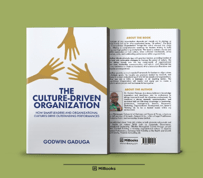By Godwin GADUGA (Dr)
As economies grapple with radical changes and new challenges emerge, entrepreneurs and business leaders must embrace leadership styles that prioritize clarity, flexibility, and innovation to thrive.” – Godwin Gaduga
To survive and thrive in today’s digital economy, many organizations are undertaking a fundamental shift from a traditional organizational model designed for the industrial economy to an agile model tailored for the digital world.
This paradigm shift heralds a new form of organization that enables innovation, collaboration, and value creation at unprecedented speed, scale, and impact. According to a McKinsey global survey, Agile organizations can develop products five times faster, make decisions three times faster, and reallocate resources adroitly and quickly.
To form and lead an agile organization successfully, leaders need a new approach. The mindsets and skills they have carefully honed over years of experience are necessary but not sufficient to lead 21st-century organizations and beyond. By evolving their leadership abilities, leaders can transform their organizations into agile entities designed for the digital economy.
Yet, understanding the nuances of an agile environment is crucial for those seeking to adapt strategic thinking skills to these dynamic settings. At its core, an agile environment is characterized by its emphasis on adaptability, continuous improvement, and the ability to respond swiftly to changes without sacrificing the project’s or organization’s overall objectives.
Understanding the Agile Environment
According to the well-known software engineer and software development pioneer Jim Highsmith, “Agility is the ability to adapt and respond to change … agile organizations view change as an opportunity, not a threat.”
As a leader, an Agile environment means an organizational culture that encourages its project teams to adopt the principles and values of the Agile approach to project management.
In other words, an Agile environment is one that is able to support the four pillars of Agile. The foundation for Agile practices, outlining four core values aimed at guiding teams toward effective collaboration and customer satisfaction
- Individuals and Interactions over Processes and Tools: Emphasizes the importance of team communication and collaboration.
- Working Software over Comprehensive Documentation: Prioritizes delivering functional software rather than excessive paperwork.
- Customer Collaboration over Contract Negotiation: Encourages ongoing dialogue with customers to ensure their needs are met.
- Responding to Change over Following a Plan: Flexibility is key, allowing teams to adjust priorities based on feedback and evolving requirements.
An agile environment thrives on collaboration and cross-functional teams where everyone has a voice, and the flow of ideas is encouraged. This ecosystem fosters innovation and allows projects to evolve organically, guided by real-time feedback and adjustments.
For leaders, this means adopting a more facilitative than directive role, guiding their teams through a process of discovery and problem-solving rather than providing solutions outright.
The shift towards agile environments has been propelled by the need for organizations to be more responsive to market changes, customer needs, people dynamics, regulatory or political changes, environmental concerns, and technological advancements.
In such a landscape, the ability to pivot quickly can be the difference between staying ahead of the curve and falling behind.
For example, consider a software development company that adopts agile methodologies to improve its product development cycle. The team can test, get feedback, and iterate on their product in real-time, thereby significantly reducing the time it takes to bring a new feature to market.
This responsiveness not only enhances customer satisfaction but also bolsters the company’s competitive edge.
However, the transition to an agile environment is not without its challenges. It requires a cultural shift within the organization, one that embraces failure as a stepping stone to innovation and emphasizes continuous learning.
Leaders must cultivate an atmosphere of trust where team members feel empowered to take initiative and experiment.
It’s about creating a safe space where the fear of failure does not stifle creativity or hinder progress (refer to my book, “The Culture-Driven Organization”). This aspect of agile environments often demands the most significant adjustment from leaders, especially those accustomed to more command-and-control styles of management.
In essence, understanding agile environments is about recognizing the power of flexibility, collaboration, and iterative progress. It’s a journey that requires leaders to be curious, open-minded, and willing to adapt their styles to harness the collective intelligence of their teams.
By doing so, they can guide their organizations through the complexities of the modern business landscape, ensuring they are not only able to respond to change but can thrive because of it.
The agility journey, therefore, is not just about adopting a new set of tools or methodologies, but about fostering a mindset that values adaptability, continuous improvement, and the relentless pursuit of excellence.
Why are Strategic Thinking Skills Important?
Leadership is more than just managing people and resources. It’s about having a vision for the future and developing a plan to achieve it.
That’s where strategic thinking comes in. Strategic thinking is the ability to see the big picture, understand how different parts of a team or project fit together, and make decisions that move toward a long-term goal.
Understanding Strategic Thinking
As a leader, strategic thinking means collaborating with your team to implement an idea or drive change.
Strategic thinking in leadership is the ability to analyze and understand the big picture of a team or project, anticipate potential challenges and opportunities, and make informed decisions that align with long-term goals.
It involves considering the short and long-term implications of decisions, prioritizing tasks and projects, and quickly adapting to market or industry changes.
Leaders who think strategically can effectively communicate their vision and goals to their team and make data-driven decisions that drive the team’s success.
It’s important to note that this skill involves both analytical and creative thinking. Leaders who think strategically must be able to gather and analyze data, identify trends and patterns, and use that information to make informed decisions.
However, they must also be able to think creatively, consider different perspectives and approaches to problems, and develop innovative solutions that move the team forward.
Another critical aspect of strategic thinking in leadership is the ability to anticipate change and plan for the future. This involves developing contingency plans to address potential challenges and taking advantage of emerging opportunities.
This is where Agile, with its structured sprints, increments, and ceremonies, comes into play, a powerful mechanism for data collection.
Agile methodologies provide a structured framework for systematically gathering valuable data throughout the project lifecycle. This not only enhances decision-making during each iteration but also contributes to a wealth of insights for continuous improvement.
The Role of Strategic Thinking in Agile Leadership
Agile leadership requires a balance between setting the strategic direction and empowering your team to determine the best approach to achieving the desired outcomes.
While you make decisions on the overall strategy, you allow your team to take ownership of the process and unleash their creativity. This approach fosters collaboration, innovation, and a sense of ownership among team members.
Applying Strategic Thinking in Agile Leadership
Strategic thinking is a crucial skill for Agile leaders who want to succeed in today’s dynamic and competitive market.
It involves taking action in collaboration with your team, overseeing the strategic direction, and providing space for your team to contribute and create solutions. Strategic thinking is not about micromanaging the details; instead, it is about empowering your team to innovate and solve problems within the established framework.
- Embrace a Shared Vision
Ensure that your team shares a clear and common vision. Take the time to describe the desired outcome and answer any questions that may arise. This shared vision will serve as a guiding light for your team, aligning their efforts and facilitating strategic decision-making.
- Establish a Framework
As a leader, you play a crucial role in creating a framework within which your team can operate. Establishing the necessary constraints, such as budget, resources, scope, and timelines, provides your team with a clear framework for decision-making. A well-defined framework enables your team to focus its efforts and work towards the intended outcomes.
- Foster a Supportive Environment
Effective leadership in Agile requires you to be in charge rather than in control. Being in charge means creating a safe and supportive environment for your team to thrive. Protect the boundaries of the project, shield your team from external distractions, and encourage their autonomy and creativity. This approach empowers your team to take ownership and deliver exceptional results.

Conclusion
In conclusion, by improving your strategic thinking skills and applying them in your agile leadership approach, you can unlock the full potential of your team, navigate uncertainties, and drive meaningful outcomes.
Well-thought-out action scenarios and data from agile sprints improve decisiveness and adaptability, which are crucial in a rapidly changing world.
Dr Gaduga is a Lecturer and a staff member of Amissah, Amissah & Co., a firm of Legal Practitioners and Notaries Public. CONTACT: 0246390969
Email Address: [email protected] / [email protected]










